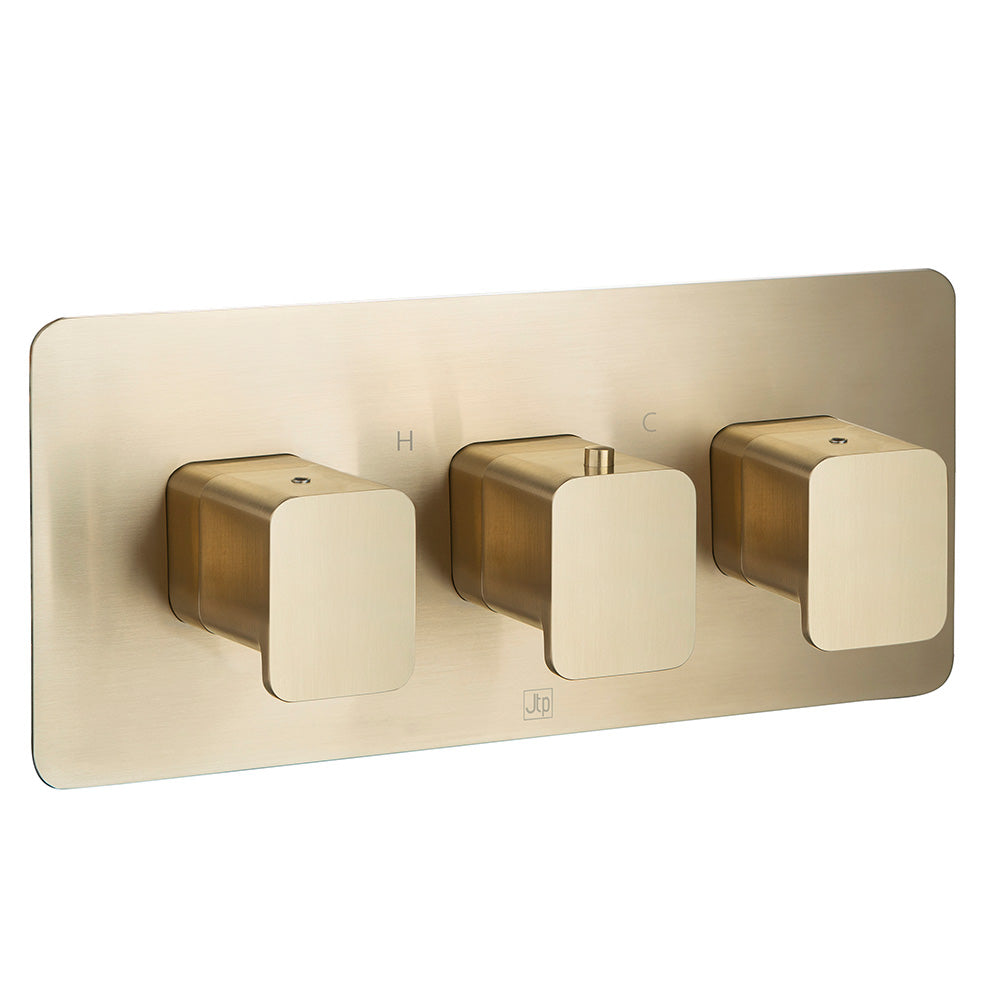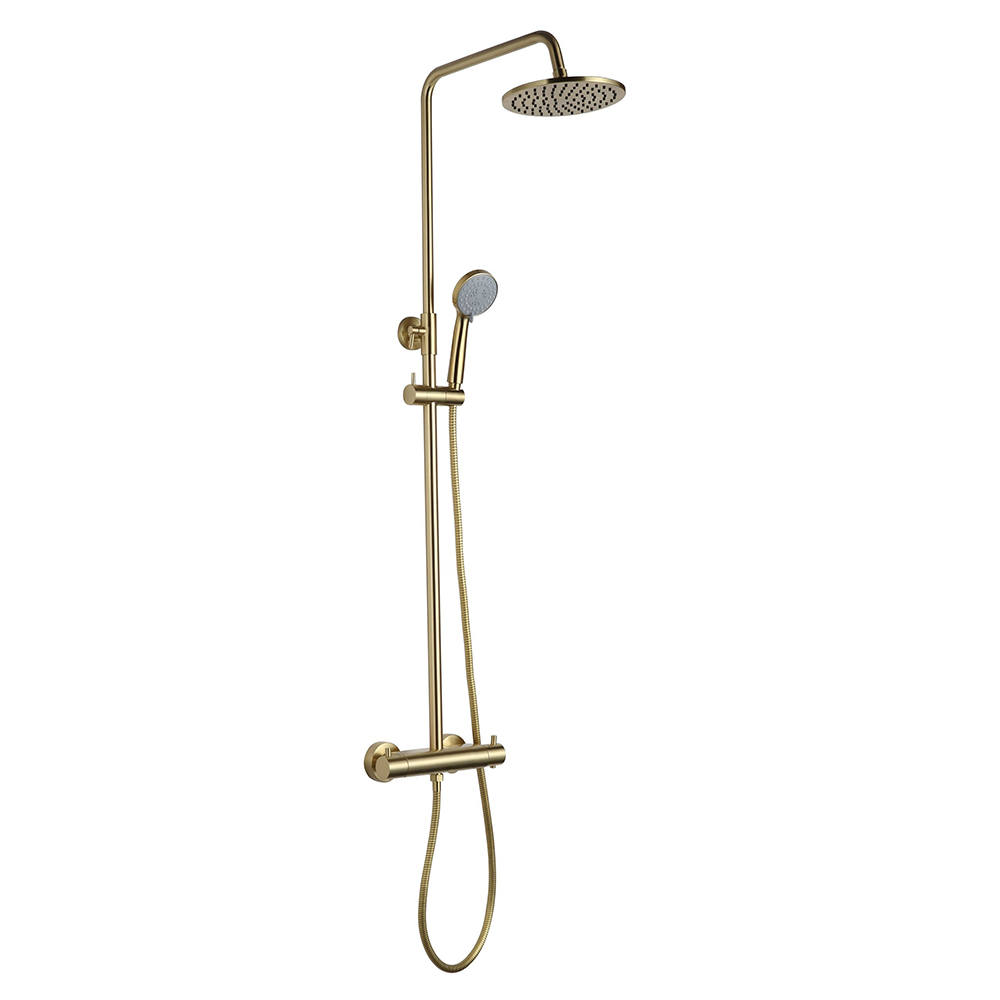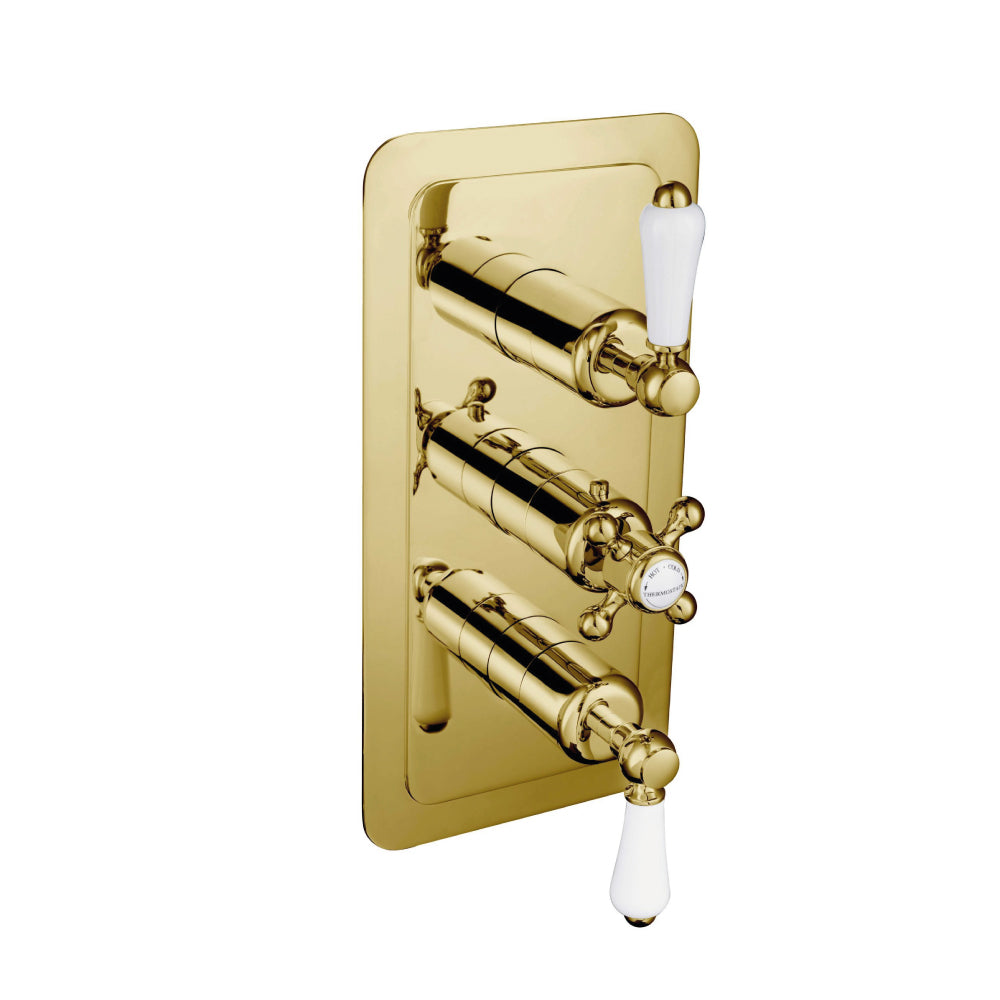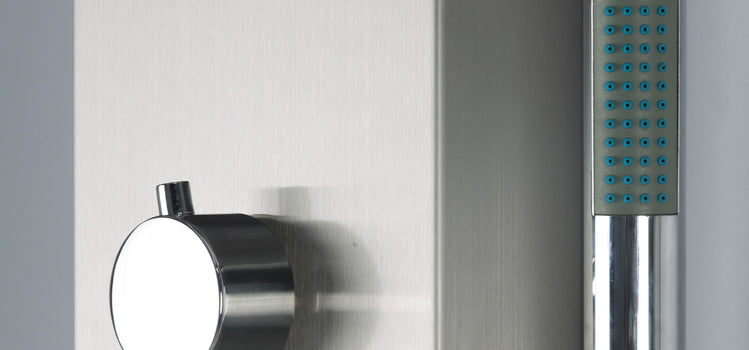Understanding shower terminology can be overwhelming for those unfamiliar with plumbing jargon. Terms like "thermostatic shower valve" or "exposed mix shower" may seem foreign until the moment you embark on designing a new bathroom or shower area. To demystify this aspect of bathroom design, we've crafted a thorough guide to shower valves. Whether you're a novice or an experienced DIY enthusiast, our guide will provide invaluable insights to help you create the perfect shower system tailored to your needs and preferences.
SHOWER VALVE TYPES :
1. SHOWER MIXER VALVE
Let's delve into the fundamentals by understanding what exactly constitutes a shower mixer. Essentially, a shower mixer serves as the cornerstone for creating a diverse array of shower experiences. Much like its counterpart, the basin mixer tap, a shower mixer valve operates on a similar principle by blending hot and cold water streams to achieve the desired temperature. This integration of hot and cold water facilitates a harmonized water temperature output. The mixed water then flows through a single outlet, typically a showerhead, before potentially being redirected to secondary channels, such as a bath filler or shower wand, depending on the configuration of your system. As we explore the myriad types of mixer valves available and offer guidance on selecting the optimal one for your project, it's crucial to keep this foundational understanding in mind.
2. CONCEALED SHOWER VALVE
Concealed shower valves, also known as recessed shower valves, are designed to be discreetly integrated within the shower wall, ceiling, or floor. This clever construction hides the valves behind the surface, leaving only a sleek plate with minimalist controls or handles visible to the user. By concealing the pipework, concealed thermostatic shower valves offer a seamless and tidy appearance to your shower enclosure.
The distinguishing feature of concealed valves is the valve plate, which serves as the sole visible component. Typically crafted from brass or metal, this plate houses the controls for the shower, maintaining a clean aesthetic while ensuring effortless operation. Concealed valve controls are available in two main configurations: push-button and handle. Push-button showers, exemplified by models like the Event Click, enable users to activate functions with a simple press. Conversely, handle controls operate via a lever mechanism, providing intuitive control over water flow and temperature adjustments.
PROS
Concealed shower valves offer a luxurious touch to any shower system, enhancing the overall aesthetic appeal of the space. By hiding the valves within the walls, ceiling, or floor, concealed valves contribute to a clean and streamlined look, particularly suitable for modern bathroom designs. One of the key benefits of concealed valves is their space-saving design, which is especially advantageous in smaller wet rooms or compact bathrooms. By eliminating visible pipework, concealed valves help maximize available space, creating an open and uncluttered environment. Moreover, concealed shower mixers can be strategically positioned away from the showerhead, providing greater flexibility and convenience in controlling water flow and temperature. This allows users to customize their shower experience according to their preferences, ensuring optimal comfort and satisfaction.
CONS
Despite their numerous advantages, concealed shower systems also come with certain drawbacks. One notable downside is the time-consuming and labor-intensive installation process associated with recessed valves. Installing a concealed shower system requires careful planning and forethought, as the valves must be embedded within the bathroom wall before tiling can commence. This adds complexity to the installation process and may require professional assistance to ensure proper placement and functionality. Additionally, the need for precise measurements and coordination with other aspects of the bathroom design can further contribute to the installation challenges associated with concealed shower valves.
What is a concealed valve for a shower?
Concealed Shower Valve: A concealed shower valve, also known as a recessed shower valve, is a type of valve that is concealed within the shower wall, ceiling, or floor. Unlike exposed valves, concealed valves are hidden from view, with only a sleek plate featuring discreet controls or handles visible to the user. Exposed Shower Valve:
In contrast to concealed valves, exposed shower valves are located outside of the shower wall. These valves can be mounted directly onto the tile or bathroom surface, with the shower pipework fully visible. Typically, an exposed valve resembles a short, narrow cylinder, flanked by hot and cold pipes on each side. Another common type of exposed valve is the bar shower valve, which features a long cylindrical design with controls at both ends. Mounted parallel to the shower wall, bar shower valves offer a space-saving alternative to traditional exposed valves, making them ideal for compact shower spaces.
The bar shower valve is another common tye of exposed valve. A bar shower valve, a long cylindrical valve that has controls at both ends and is mounted parallel to the wall of the shower, is a type of exposed valve. Bar shower valves take up slightly less space than traditional, exposed valves making them great for small shower spaces.
PROS
Exposed shower valves offer cost-effective solutions and easier installation processes compared to concealed valves. They eliminate the need for recessing into bathroom walls, as they can be conveniently mounted directly on top of existing tiles or bathroom surfaces. This streamlined installation process saves both time and labor costs, making exposed valves a practical choice for various bathroom projects.
CONS
Exposed shower mixers lack the discreetness of concealed valves, as they project outward from the wall, potentially compromising the aesthetic appeal of your shower space. Unlike concealed valves, which offer a clean and seamless finish, exposed valves may detract from the overall look of your bathroom design. Additionally, exposed valves are more prone to limescale buildup due to their exposed position, requiring regular maintenance to ensure optimal performance and appearance.
What is an exposed shower, Val?
An exposed shower valve is a type of shower valve that is positioned outside of the shower wall, typically mounted directly onto the tiles or bathroom floor. Unlike concealed valves, which are hidden within the wall, exposed valves have their pipework visible. This style of valve is characterized by its external placement and is often installed as a prominent feature in the shower area.
3. THERMOSTATIC SHOWER VALVE
Thermostatic shower valves offer precise control over water temperature to ensure a safe and comfortable showering experience. These valves are designed to prevent water from reaching scalding temperatures by allowing users to set a maximum temperature limit. By restricting the valve's rotation, users can adjust the water temperature from cool to warm within a predetermined range.
The thermostatic mixer shower functions by maintaining a constant water temperature regardless of fluctuations in the hot and cold water supply. This is achieved through a built-in thermostat that reacts to changes in water temperature and adjusts the flow of hot and cold water accordingly. As a result, users can enjoy a consistent water temperature throughout their shower, minimizing the risk of accidental scalding. Typically, the temperature of a thermostatic valve is pre-set during manufacturing to meet safety standards. In the UK, the recommended temperature for showering falls between 39 and 41 degrees Celsius. While it is possible to calibrate the mixer temperature before installation for a hotter shower, this task is best left to a qualified plumber or installer to ensure proper functionality and safety. Thermostatic valves are available in both concealed and exposed configurations to suit different bathroom designs and preferences. Whether recessed within the wall or mounted externally, thermostatic shower valves offer convenience, safety, and peace of mind for users.
PROS
Thermostatic shower mixers offer an unparalleled level of safety compared to standard shower valves. Their ability to maintain a consistent water temperature makes them ideal for family bathrooms where the risk of accidental scalding is a concern. By setting a maximum temperature limit, thermostatic mixers provide peace of mind to users, especially households with young children or elderly individuals. In addition to safety, thermostatic shower mixers enhance the overall showering experience by ensuring a comfortable water temperature from start to finish. Users no longer need to worry about sudden fluctuations in water temperature, allowing them to relax and enjoy their shower without the fear of being exposed to excessively hot water. Furthermore, the convenience of thermostatic mixers extends beyond safety considerations. These valves eliminate the need for manual adjustments to maintain the desired water temperature, saving time and effort during each shower. With a simple turn of the handle, users can achieve the perfect balance of hot and cold water without the hassle of constantly readjusting the settings. Overall, the safety, comfort, and convenience offered by thermostatic shower mixers make them a preferred choice for modern bathrooms seeking both functionality and peace of mind.
CONS
While thermostatic shower mixers offer superior safety and convenience, there are some considerations to keep in mind. One potential drawback is the need to verify and potentially adjust the valve's temperature setting before installation. This step ensures that the mixer is calibrated to the desired temperature range, typically between 39 and 41 degrees Celsius in the UK, to prevent scalding accidents. Adjusting the temperature setting may require technical expertise and should ideally be handled by a qualified plumber or installer. Attempting to calibrate the mixer without proper knowledge or tools could result in incorrect temperature settings, compromising the safety of the showering experience. Additionally, some thermostatic shower mixers may require periodic maintenance to ensure optimal performance. Over time, mineral deposits or limescale buildup could affect the valve's functionality, leading to fluctuations in water temperature or reduced efficiency. Regular cleaning and maintenance may be necessary to address these issues and maintain the mixer's safety and reliability. Despite these considerations, the safety benefits of thermostatic shower mixers often outweigh any potential drawbacks, making them a popular choice for households prioritizing safety and comfort in their bathrooms.
What is a thermostatic valve for showers?
A thermostatic valve for showers is a specialized type of shower valve designed to regulate water temperature and prevent scalding. Unlike standard shower valves, which require manual adjustment to achieve the desired water temperature, thermostatic valves feature built-in temperature controls that automatically maintain a consistent water temperature. These valves are equipped with a thermostatic cartridge or mechanism that senses changes in water temperature and adjusts the flow of hot and cold water accordingly to maintain a preset temperature level. This proactive approach to temperature regulation helps prevent sudden fluctuations in water temperature that could result in scalding or discomfort during showering. Thermostatic shower valves are especially popular in households with young children or elderly individuals, as they offer enhanced safety by minimizing the risk of accidental burns or scalds. Additionally, they provide greater convenience and peace of mind for users, as there is no need to manually adjust the temperature each time they shower. In summary, a thermostatic valve for showers is an essential component of a modern bathroom, providing reliable temperature control and safety features to ensure a comfortable and enjoyable showering experience for users of all ages.
STYLES
The world of shower valve designs offers a diverse array of options to suit various tastes and preferences. With an extensive selection available, homeowners can easily find the perfect style to complement their bathroom decor. From classic Victorian-inspired designs to elegant heritage-inspired models and sleek modern creations, there is a shower valve style to suit every aesthetic. Exploring the range of styles available allows individuals to personalize their bathroom space and create a cohesive look that reflects their unique sense of style. Whether you prefer the timeless elegance of vintage-inspired designs or the contemporary allure of modern fixtures, there is a shower valve style that will enhance the aesthetic appeal of your bathroom. By understanding the different styles of shower valves available, homeowners can make informed decisions when selecting the perfect option for their bathroom renovation or remodeling project. Whether you're aiming for a traditional, transitional, or modern look, the right shower valve design can elevate the overall aesthetic and functionality of your bathroom space.
4. TRADITIONAL SHOWER VASES
Classic in their design, traditional shower valves evoke the timeless elegance of Victorian-era brass fixtures. These shower valves typically feature exposed configurations, showcasing the intricate details of the plumbing system. Adorned with fixed, dome-shaped shower heads, traditional valves exude a sense of sophistication and refinement. Available in a range of finishes such as chrome or brass, traditional shower valves add a touch of luxury to any bathroom setting. Their exquisite craftsmanship highlights the beauty of the shower pipework, creating a focal point that enhances the overall aesthetic appeal of the space. Whether finished with gleaming chrome or warm brass tones, these valves offer a nod to the bygone era while providing modern functionality. Characterized by terminal lever handles or crosshead handles, traditional shower valves exude a sense of nostalgia, inviting users to indulge in a showering experience reminiscent of days gone by. With their classic design elements and attention to detail, these valves bring a sense of timeless charm to any bathroom decor scheme.
5. CONTEMPORARY SHOWER VALVE
Sleek and minimalist, contemporary shower valves offer a seamless blend of style and functionality, perfect for modern bathroom designs. These valves are designed to complement the clean lines and sleek surfaces characteristic of contemporary interiors. With their understated elegance, contemporary shower valves add a touch of sophistication to any shower space. Ideal for achieving a minimalist aesthetic, contemporary shower valves can be concealed within the shower wall, creating a streamlined look that enhances the overall design of the bathroom. This hidden installation ensures that the focus remains on the sleek lines and uncluttered surfaces of the space. When it comes to finishes, contemporary shower valves shine in matte or high-shine chrome, offering a modern and polished appearance. The chrome finish adds a touch of sophistication while seamlessly blending with other fixtures and accessories in the bathroom. In terms of design, contemporary shower valves feature simple and refined elements, such as round or soft-square levers, that contribute to their sleek aesthetic. Some models may even incorporate a convenient push-button on/off mechanism, enhancing ease of use and functionality. With their modern design and practical features, contemporary shower valves are the perfect choice for homeowners looking to create a stylish and functional shower space that reflects their contemporary taste and lifestyle.
6. TRANSITIONAL SHOWER VALVE
Combining elements of both traditional and modern design, the transitional shower valve offers a unique blend of timeless elegance and contemporary sophistication. This innovative valve seamlessly integrates the sleek aesthetics of modern brassware with the classic detailing reminiscent of traditional valves. At its core, the transitional shower valve features the concealed installation characteristic of modern design, with sleek backplates that contribute to a clean and minimalist appearance. This hidden installation allows the valve to seamlessly merge with the surrounding shower wall, creating a seamless and cohesive look that enhances the overall aesthetic of the bathroom. However, what sets the transitional shower valve apart is its incorporation of heritage-inspired detailing, which adds a touch of timeless charm to the modern design. From intricately crafted lever handles to classic crosshead detailing, these elements pay homage to the traditional brassware designs of yesteryears, infusing the valve with a sense of heritage and nostalgia. The combination of modern functionality and traditional aesthetics makes the transitional shower valve a versatile choice for a wide range of bathroom styles. Whether you're looking to create a classic, vintage-inspired bathroom or a sleek, contemporary space, the transitional shower valve offers the perfect balance of old-world charm and modern convenience.
When shopping for shower valves in the UK, it's essential to know what to look for to ensure you make the right choice. You can find helpful tips and points to consider in this comprehensive guide on 'Shopping for the Best Shower Valves in the UK? Know These 7 Points Before You Buy!'.







No comments:
Post a Comment